Adult panic attacks can be triggered by various factors, including work stress, significant life changes, and relationship issues. The pressure of daily responsibilities and unexpected transitions can lead to overwhelming anxiety, resulting in intense feelings of fear and helplessness. Understanding these triggers and implementing effective coping strategies is essential for managing and reducing the impact of panic attacks in everyday life.
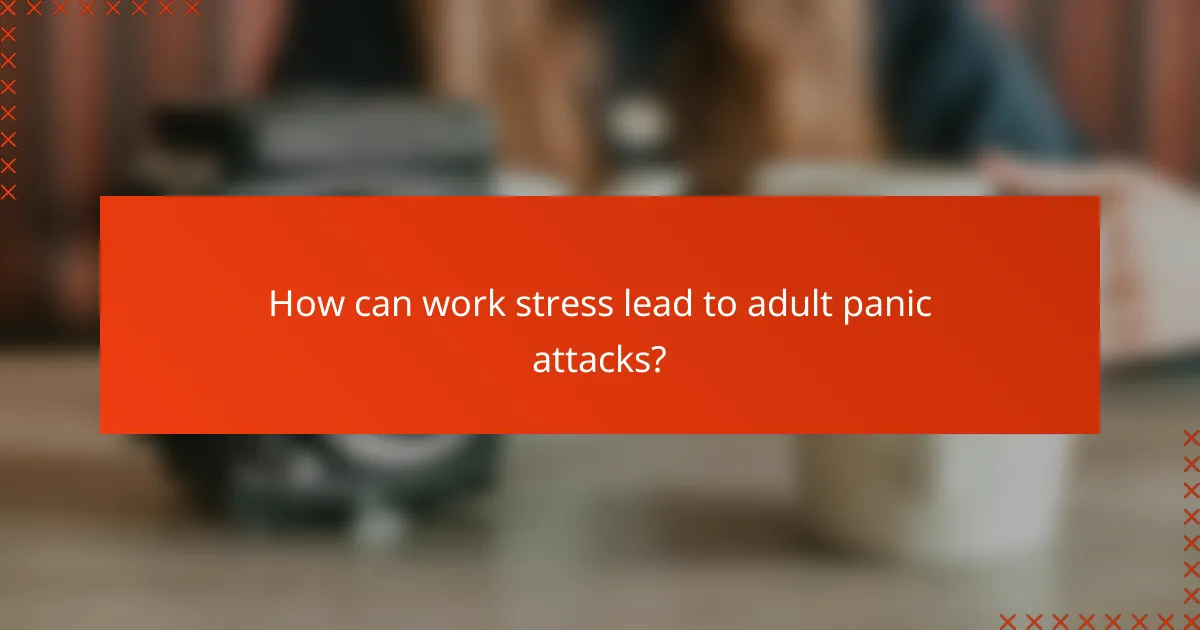
How can work stress lead to adult panic attacks?
Work stress can significantly contribute to the onset of adult panic attacks by overwhelming individuals with anxiety and pressure. When stressors accumulate, they can trigger intense feelings of fear and helplessness, leading to panic attacks.
Increased pressure from deadlines
Deadlines create a sense of urgency that can escalate stress levels. When employees feel they cannot meet these expectations, it can lead to anxiety that manifests as panic attacks. For instance, consistently tight deadlines may result in feelings of inadequacy and overwhelm.
To manage this pressure, it’s essential to prioritize tasks and set realistic goals. Breaking projects into smaller, manageable parts can help alleviate the stress associated with looming deadlines.
Workplace conflicts and dynamics
Conflicts with colleagues or supervisors can create a toxic work environment that heightens stress. Negative interactions can lead to feelings of isolation and anxiety, which may trigger panic attacks. For example, ongoing disputes can create a sense of dread about going to work.
To mitigate these issues, open communication is vital. Addressing conflicts early and seeking mediation can help restore a healthier workplace dynamic.
Job insecurity and financial concerns
Job insecurity is a significant source of stress that can lead to panic attacks. Concerns about layoffs or financial instability can create a constant state of anxiety. For many, the fear of losing a job translates into worries about meeting financial obligations, such as rent or mortgage payments.
To cope with these fears, individuals can focus on building an emergency fund and exploring additional income sources. This proactive approach can provide a sense of security and reduce anxiety related to job stability.
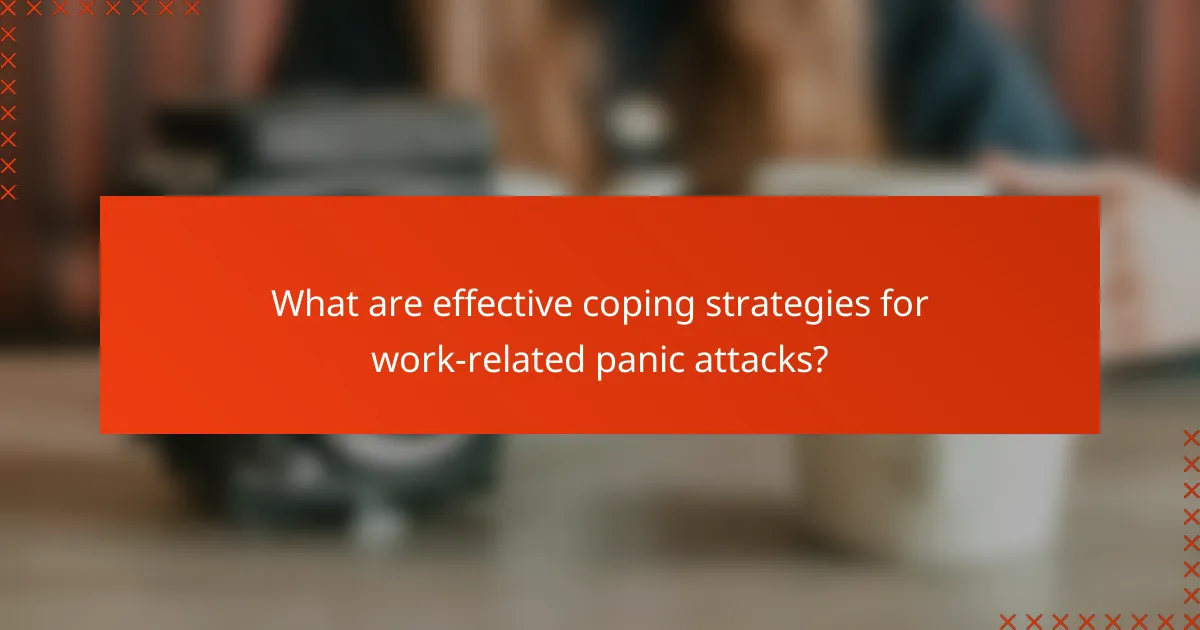
What are effective coping strategies for work-related panic attacks?
Effective coping strategies for work-related panic attacks include techniques that help manage stress and anxiety, such as mindfulness, time management, and seeking professional support. Implementing these strategies can significantly reduce the frequency and intensity of panic attacks in a workplace setting.
Mindfulness and meditation techniques
Mindfulness and meditation can help ground you during moments of panic by focusing your attention on the present. Techniques such as deep breathing, body scans, or guided imagery can be practiced in just a few minutes and can be done discreetly at work.
Consider setting aside a few minutes each day for mindfulness exercises. Apps like Headspace or Calm can provide structured guidance and help you build a consistent practice. Regular use can enhance your ability to manage stress and reduce anxiety over time.
Time management and prioritization
Effective time management can alleviate feelings of being overwhelmed, which often trigger panic attacks. Break tasks into smaller, manageable steps and prioritize them based on urgency and importance. This approach can create a clearer path to completing your work without feeling pressured.
Utilize tools like to-do lists or digital planners to keep track of tasks. Aim to allocate specific time blocks for focused work, allowing for short breaks to recharge. This method can help maintain productivity while reducing anxiety about deadlines.
Seeking professional support
Seeking professional support is crucial for managing work-related panic attacks. A therapist or counselor can provide tailored strategies and coping mechanisms that address your specific challenges. They can also help identify underlying issues contributing to your anxiety.
Consider exploring options such as cognitive-behavioral therapy (CBT), which has been shown to be effective for anxiety disorders. Many workplaces offer Employee Assistance Programs (EAPs) that provide access to mental health resources at no cost, making it easier to seek help when needed.
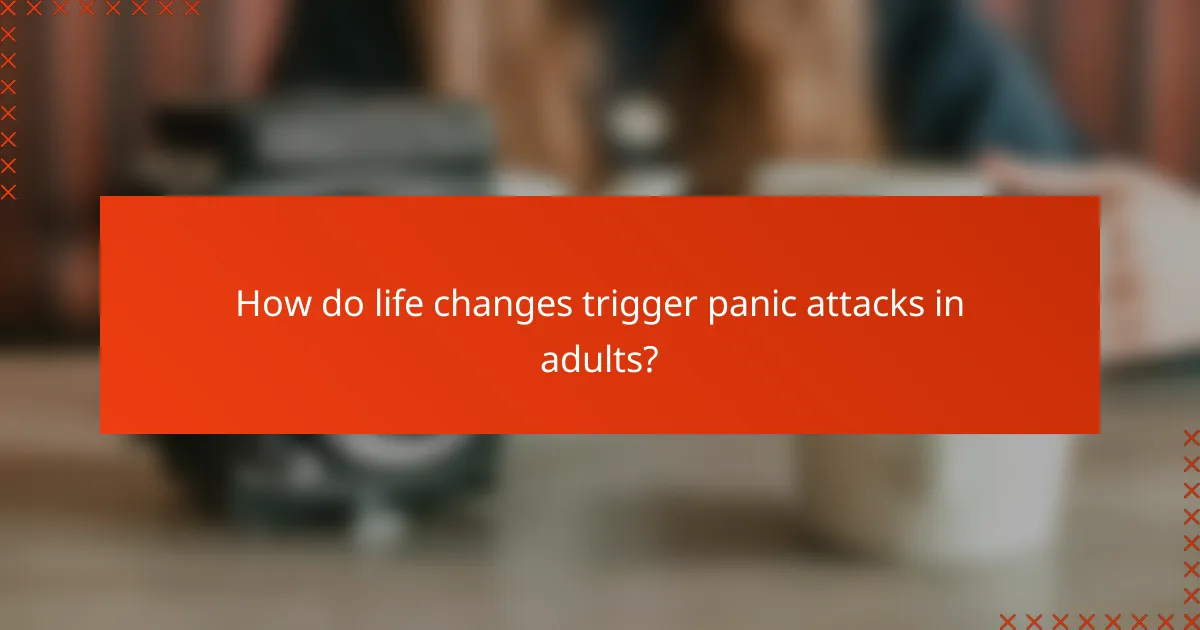
How do life changes trigger panic attacks in adults?
Life changes can significantly trigger panic attacks in adults by creating stress and uncertainty. These transitions often disrupt routines and introduce new challenges that can overwhelm an individual’s coping mechanisms.
Major life transitions like moving
Moving to a new location can be a major source of stress, leading to feelings of anxiety and panic. The process involves not only physical relocation but also adjusting to a new environment, which can feel daunting.
To manage this stress, it’s helpful to plan the move carefully, breaking it down into smaller, manageable tasks. Consider creating a checklist to track progress and reduce feelings of chaos.
Changes in family dynamics
Shifts in family dynamics, such as divorce, the birth of a child, or the loss of a family member, can evoke strong emotional responses. These changes can lead to feelings of instability and fear, triggering panic attacks.
Open communication with family members can help ease anxiety during these transitions. Seeking support from friends or professionals can also provide a necessary outlet for emotions.
Health-related changes
Health-related changes, such as a new diagnosis or chronic illness, can create significant anxiety and uncertainty. The fear of the unknown regarding health can lead to heightened stress levels and panic attacks.
Staying informed about health conditions and engaging with healthcare providers can help alleviate fears. Establishing a support network of friends, family, or support groups can also provide comfort during these challenging times.
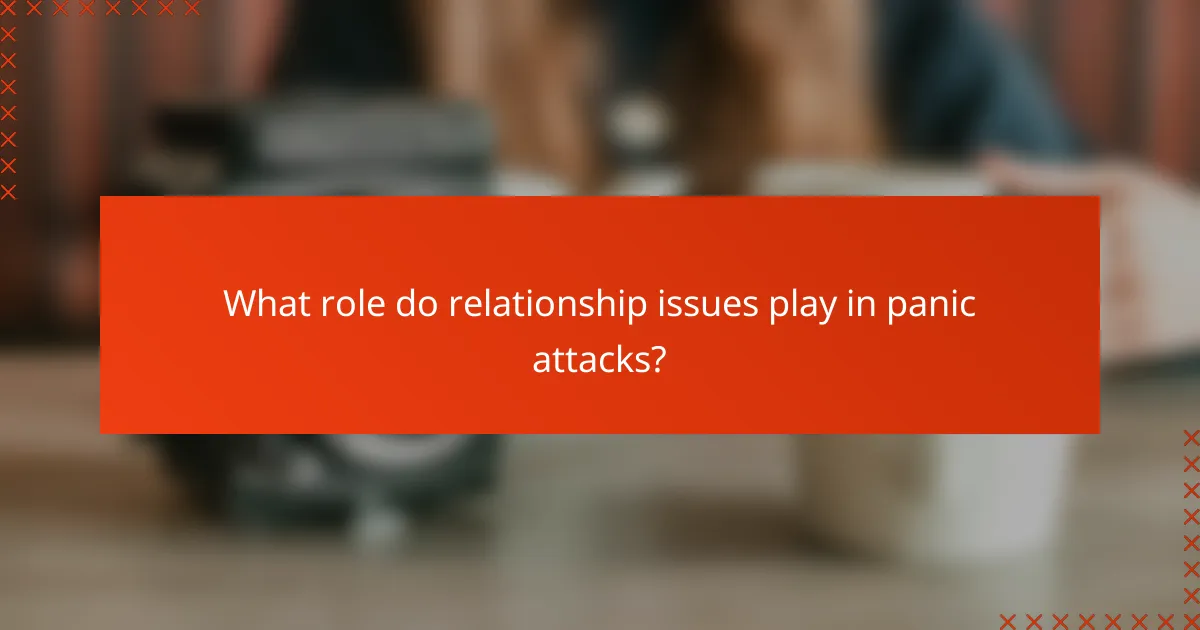
What role do relationship issues play in panic attacks?
Relationship issues can significantly contribute to the onset of panic attacks by creating emotional turmoil and stress. Conflicts, misunderstandings, and lack of support in personal relationships can trigger anxiety, leading to panic episodes.
Communication breakdowns
Effective communication is crucial in any relationship, and breakdowns can lead to misunderstandings and unresolved issues. When partners fail to express their feelings or listen to each other, it can create a cycle of frustration and anxiety, heightening the risk of panic attacks.
To improve communication, consider setting aside regular time for open discussions. Using “I” statements can help express feelings without placing blame, fostering a more supportive dialogue.
Emotional dependency and stress
Emotional dependency occurs when one partner relies heavily on the other for validation and support. This dependency can create pressure and stress, especially if the relationship is strained. Such stress can be a significant trigger for panic attacks.
To mitigate emotional dependency, both partners should work on building individual self-esteem and resilience. Engaging in personal hobbies and maintaining friendships outside the relationship can help reduce reliance on one another.
Conflict resolution strategies
Effective conflict resolution is essential for maintaining healthy relationships and reducing anxiety. Strategies such as active listening, finding common ground, and agreeing to disagree can help partners navigate disagreements without escalating tensions.
Consider implementing a structured approach to conflict resolution, such as the “time-out” method, where both partners take a break to cool down before discussing the issue. This can prevent conflicts from spiraling into panic-inducing situations.
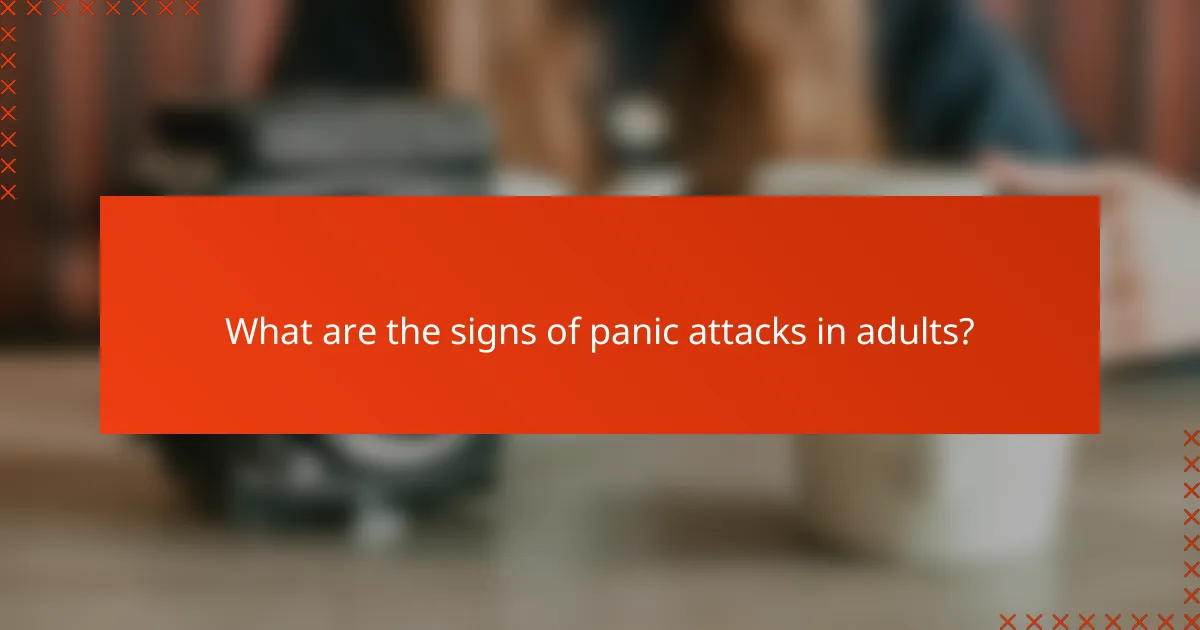
What are the signs of panic attacks in adults?
Panic attacks in adults are characterized by sudden, intense feelings of fear or discomfort that peak within minutes. Common signs include physical symptoms like rapid heartbeat and cognitive symptoms such as overwhelming anxiety about losing control.
Physical symptoms like heart palpitations
Physical symptoms of panic attacks often manifest quickly and can be quite distressing. Heart palpitations, which feel like your heart is racing or pounding, are among the most common signs. Other physical symptoms may include shortness of breath, sweating, trembling, and dizziness.
Recognizing these symptoms early can help you manage a panic attack more effectively. If you experience heart palpitations, try to focus on your breathing—taking slow, deep breaths can help calm your heart rate. Avoiding caffeine and other stimulants may also reduce the likelihood of experiencing these symptoms.
Cognitive symptoms like fear of losing control
Cognitive symptoms during a panic attack often involve intense feelings of fear, particularly the fear of losing control or going crazy. This mental distress can create a cycle of anxiety, making the experience even more overwhelming.
To cope with these cognitive symptoms, grounding techniques can be beneficial. Focus on your surroundings by identifying objects you can see, hear, or touch. This practice can help redirect your thoughts and reduce feelings of panic. Additionally, talking to someone you trust about your feelings can provide reassurance and support.
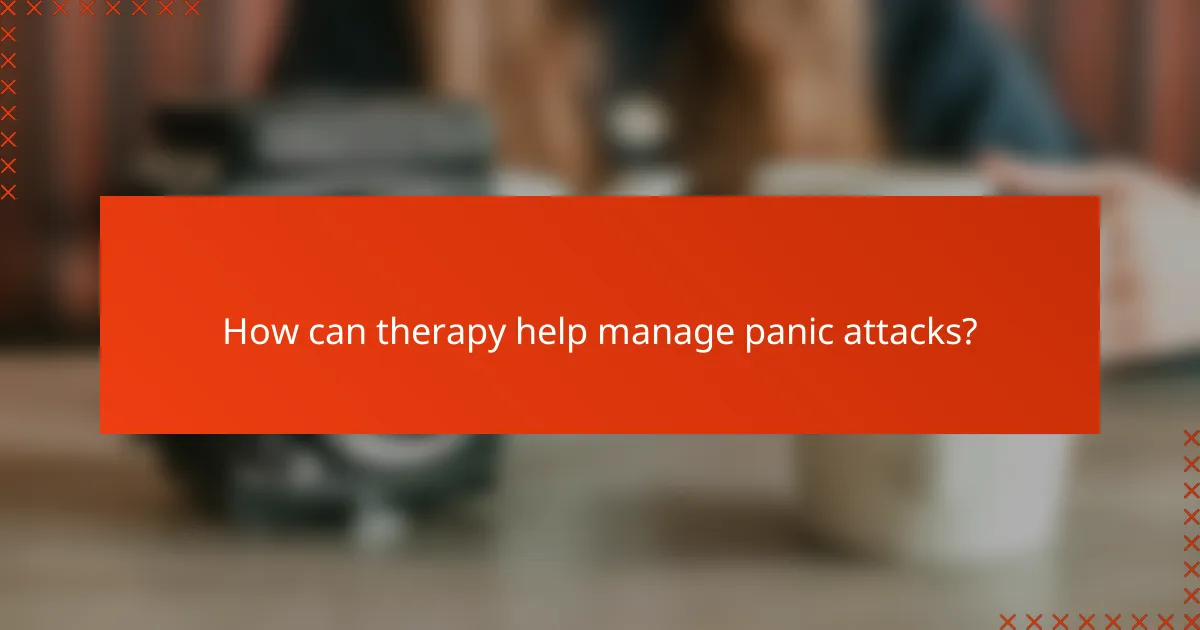
How can therapy help manage panic attacks?
Therapy can be an effective way to manage panic attacks by providing coping strategies and addressing underlying issues. Through various therapeutic approaches, individuals can learn to identify triggers, develop relaxation techniques, and reframe negative thoughts associated with panic.
Cognitive Behavioral Therapy (CBT)
Cognitive Behavioral Therapy (CBT) is a widely used approach for treating panic attacks. It focuses on identifying and changing negative thought patterns that contribute to anxiety. By working with a therapist, individuals can learn to challenge irrational beliefs and replace them with more balanced thoughts.
CBT often includes exposure therapy, where individuals gradually face their fears in a controlled environment. This process helps desensitize them to the triggers of their panic attacks, making it easier to manage anxiety in real-life situations.
Mindfulness and Relaxation Techniques
Mindfulness and relaxation techniques can significantly aid in managing panic attacks. These methods encourage individuals to focus on the present moment and reduce anxiety through practices like deep breathing, meditation, and progressive muscle relaxation. Regular practice can help lower overall stress levels.
In therapy, a professional can guide individuals in developing a personalized mindfulness routine. This can include short daily sessions that gradually build resilience against panic symptoms, making it easier to cope when anxiety arises.
Medication as a Complement to Therapy
In some cases, medication may be recommended alongside therapy to manage panic attacks effectively. Antidepressants or anti-anxiety medications can help stabilize mood and reduce the frequency of panic episodes. However, medication should be considered as part of a comprehensive treatment plan.
Consulting with a healthcare provider is essential to determine the most appropriate medication and dosage. Regular follow-ups can ensure that the treatment remains effective and any side effects are managed properly.


